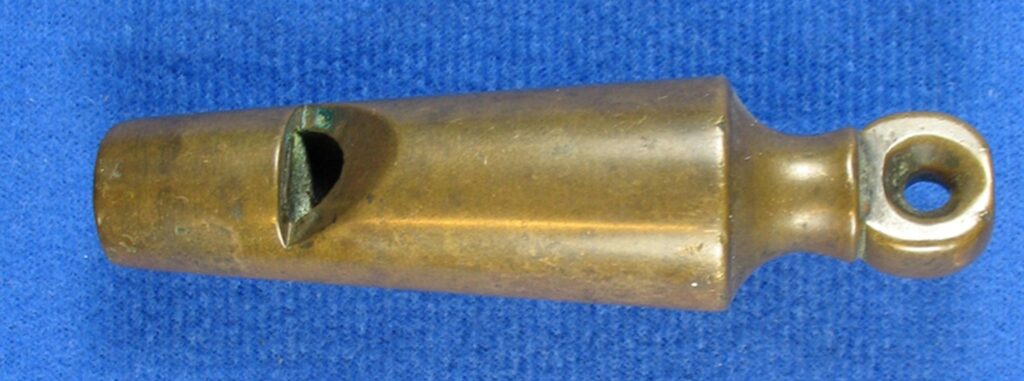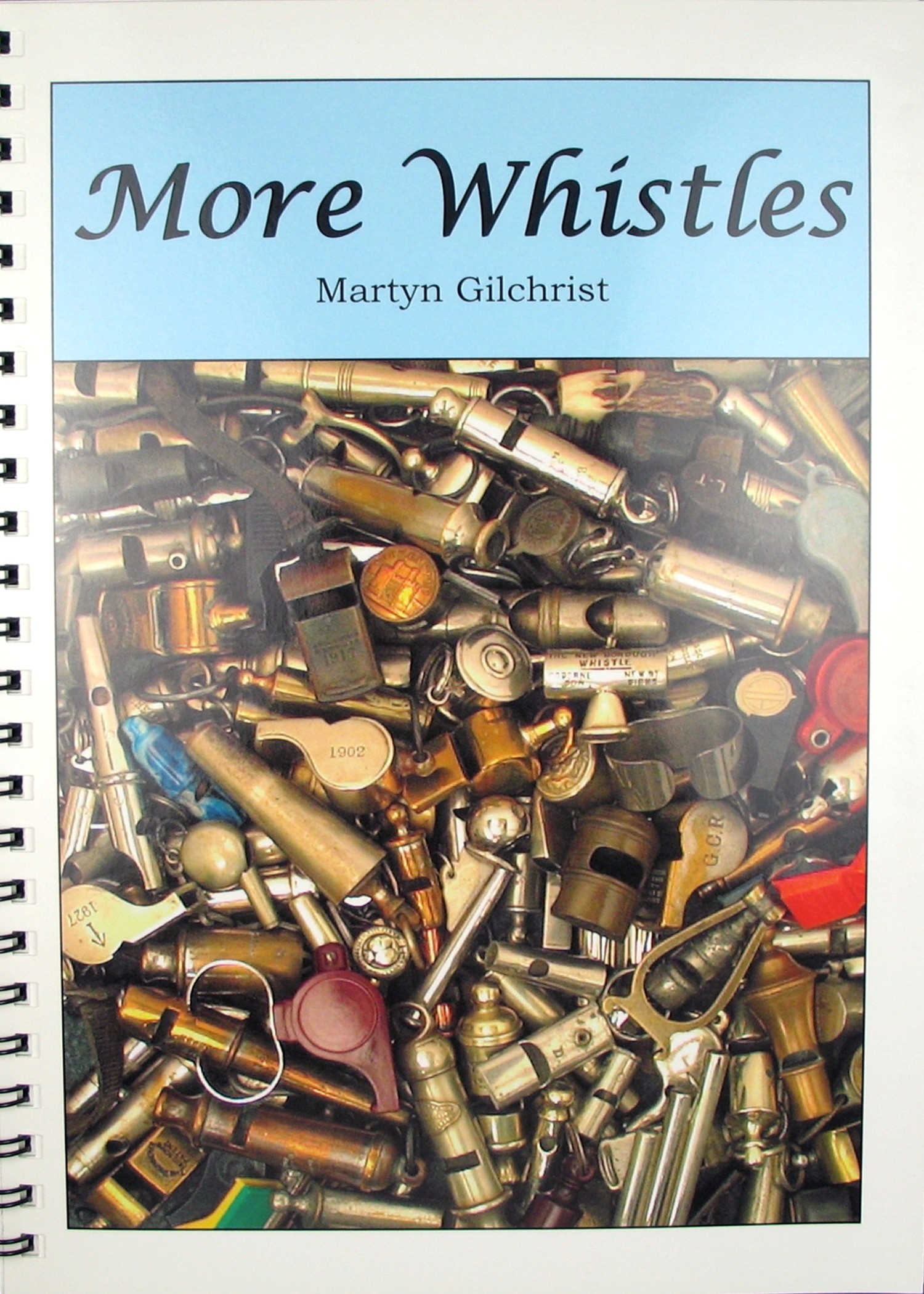Whistory
Arguably many of the best vintage metal whistles made, especially in production amounts, came from the UK. ( However, we might add France and Germany.) Perhaps because, as it was said, they ruled the seven seas and the sun never set on their empire – at least at their zenith — theirs is a long history of craftmanship and at the same time, geographical spread. Certainly, their boatswain whistles led the charge worldwide. They were the world power at one time and industry came with it.
How whistles came to the fore...
There was a period where, due to a convergence in history, everything came together for manufacturing and use. Communication still needed assistance before telephone and cell phones. Along with these elevated production levels, came high quality whistles with much fewer labor costs than we see today. With regard to the years 1850 to 1930 they were perhaps the peak years ( or golden age ) in the UK, at least for whistles. Other countries were no exception.
This does not include bosun pipes with their history extending further back as early as the 1500s ( or even earlier? )in high quality silver work. However it may turn out to be the same case in other countries ( i.e. Germany, France, America, Argentina, Russia, China etc. ) of this golden age of whistles.
So then, deservedly so, much attention has been given to UK whistles and for various other reasons, one of which was three books written by Martyn Gilchrist ( and Simon Topman ). These highlighted and revolved around the Joseph Hudson Company nestled in Birmingham. Rightfully so, as it emerged as a worldwide center point of whistle making.
Another reason is that Police whistles have become very popular to collect as well as fire brigade and asylum whistles, both coming under the Metropolitan umbrella during this time period, which became a tradename there. These are clearly stamped to identify them with facilities for such use, which was sorely lacking in so many other countries of the day.
American made whistles emerge...
This being said, this particular SPOTLIGHT is to raise awareness of American whistles. Being a much younger country, especially on the west side, finds that whistle makers did not develop the quality and diversity to the extent of their UK counterparts.
Bosun pipes were mostly made larger, round whistles are almost nonexistent. Some exploring of hunting whistles grew before 1900, some cycling. However, variety has to be searched for. None the less, there are jewels to be found.
So, we find whistles dating not much further back in history in the USA, than the middle of the ‘golden age’ in the UK. Older examples may appear of course, but generally not production levels near the level of the UK, France or Germany.
Future SPOTLIGHTs will highlight different American makers. This SPOTLIGHT is focusing across the board on some variety of whistles made in the USA.
Whistle Classification
For the future classifying and describing of whistles, the following format will be used to describe for our study purposes, how they are tagged and entered into the database of the Whistle Gallery reference collection and for internet research.
| Category | gadget escargot round duplex circumferential siren GSW |
Order | Frary North Brothers BGI Fischer Unknown Johnson Chase Bean |
| Type | police general cycling alarm |
| Class | tin brass copper steel pot metal |
Whistle Archaeology
Catalogs, advertisements, and patents will be under the individual Spotlights in this section.
Whistology
Frary knife whistles
First up is a knife combination patented in the USA by James A. Frary in 1880. The smaller end is crafted into a whistle ( usually damaged ), and one may note the detailed work on the sides…
There is another model with two blades. This example was a production whistle, these can be found with a diligent search.
North Brothers whistles
Next up, is the striking whistle of the only known example by North Brothers, of an escargot of unique design. Perhaps a proto-type it is a mono-typical example, and is stamped several times with Patent numbers and pending. None of which has been found on any patent searches.
Circa 1897, the North Brothers, best known for tools, were in Philadelphia Penn. USA. Note there is no knop for a suspension chain and also the evident drill holes facilitating the cuts of the window. It does contain the original cork ball, not wooden.
Bridgeport Gun Implement Company (BGI)
The Bridgeport Gun Implement Company known simply as BGI, made many types of whistles of metal and other materials like horn, as the largest whistle making company of its day in the states, circa 1890.
Shown here is one of two sizes model #601 a 50 caliber bullet ( model #601C being the other ). It is very high pitched, almost shrill and made with exceptional quality for a very early production whistle.
Patented by Charles Leet in 1881, there followed a few variations, mainly in the knops. See SPOTLIGHT # 44.
Dual tube and multi tubed whistles
Dual tube and multi tubed whistles came to be quite popular in many designs. Here is an early model with an extended mouthpiece patent dated 1864, but not found as yet in specific drawings. The modification of the extended mouthpiece may have been custom made or ordered.
A.L. Fischer would go on to patent ‘improvements’ in 1885, 21 years later. Banks and Brother would produce a dual tube whistle decades later utilizing a serrated diaphragm, while the cycling company the Overman Wheel Company ( the assigner to the Fischer patent ) would use a smooth diaphragm ( along with another cycling entrepreneur R. Phillip Gormally ) See SPOTLIGHT # 48
Beaufort (conical) whistles
A massive example of a ‘beaufort’ ( or conical ) like whistle follows, more like a round whistle with one window.
It is not known whether it was to be production made or not. Quite heavy at 109 grams, it is made with very thick brass and appears to be made from a single piece of stock, yet there is a remarkably thick diaphragm somehow inserted inside.
No other examples have been seen.
This whistle is made with an unusual attribute of just one window like a round whistle, but designed as a beaufort/conical shaped whistle.
Cycling whistles
F.L. Johnson in 1889 patented the following whistle for cycling enthusiasts. It is long at 12 MM and light weight. The sound is a hollow deep sound, not like a train sound at all, even though with the four extensions splitting the sound, it looks like it would sound so. Note the extensions soldered on to the mouthpiece. This was a production made whistle and other examples can be found also with variations. Johnson also patented a large dual two tube thin wall whistle.
Sirens
In a similar category that falls in the whistle realm we also find sirens. F.S. Chase in 1895 patented a brass sheet metal siren that other manufacturers expanded the use of in the USA. This example is pixie size, yet fully functional. The curved openings on the end were distributed by B&R later in their own variety and sizes, also of a rolled metal sheet construction. This one measures just 0ver 3 MM, titled Little Siren
Police whistles
Lastly, we take a look at a very heavy, 47 grams, two window, police whistle. Patented in 1881 and stamped so, on the inside on the diaphragm/disc, by the inventor E.D. Bean . He did not make them, but farmed them out to others who specialized in production of police equipment.
It is well constructed, cast and ahead of its time in craftsmanship. The entire top knop and cap is a single brass piece and the mouthpiece attaches just below the window, as a second of three pieces — besides the diaphragm. A much lighter and thinner sheet metal type of construction came to be used in a later model and eventually four known examples. See SPOTLIGHT # 43
Conclusions:
In this SPOTLIGHT we have just touched on a variety of American designed and manufactured whistles. There are many more right now to be studied, discussed, and shown. Hopefully, these will continue to surface.
British whistles have dominated the collecting field, but this no longer needs to be the case. France has outstanding and sometimes extremely artistic whistles, that are not often seen outside their country.
Germany has fine whistles to be discovered and had large whistle making companies rivaling the UK. They are quite hard to find post war times, perhaps having been melted down or recycled for armaments, however, they do surface from time to time.
This is not to mention robust well-crafted German and French torpedo sirens of different models. Argentina has produced some interesting examples of a variety of whistles and models, as has China of which we probably have not scratched the surface of, when it comes to vintage whistles.
We hope this spotlight has sparked your desire to delve deeper into the history, design and variety of whistles from around the world. Please feel free to write, send pictures and perhaps share some information that will contribute to the world wide data base.
TWG
Post March 3, 2012
Revised May 19, 2020
Revised October 10, 2020
Revised February 12, 2021
Revised December 27, 2021
Revised December 29, 2021
Revised January 30, 2022
Bibliography:
na
© – All photos with blue background property of The Whistle Gallery reference collection. Please contact The Whistle Gallery for permission of use of any website content. Spotlight articles are copyrighted. Please contact The Whistle Gallery for permission of use of any website or Spotlight article material written or otherwise. Use of photos without authorization is prohibited.
Where to Learn More:
Spotlight > Research Articles > 001 American Made Whistles – Variety

















